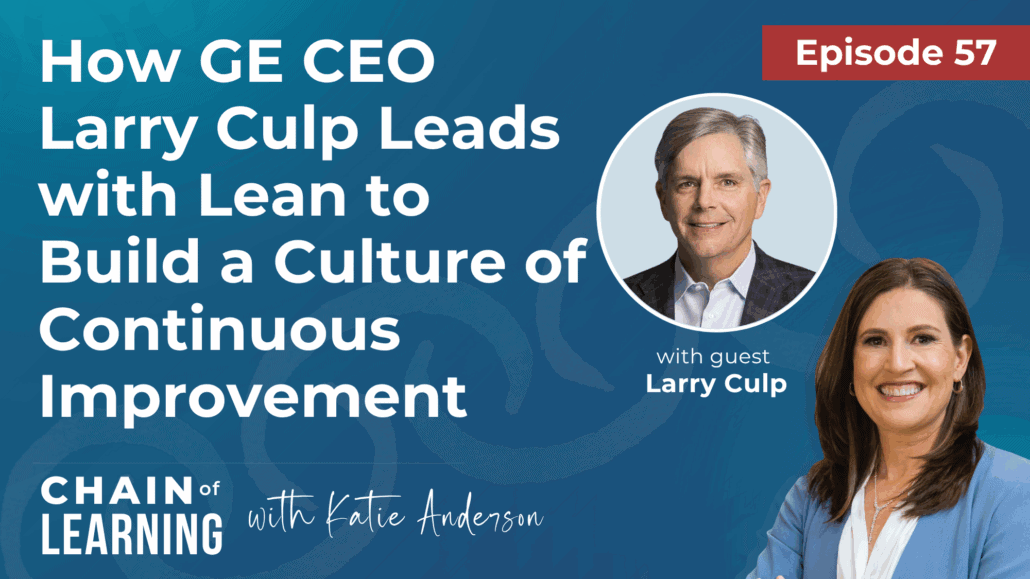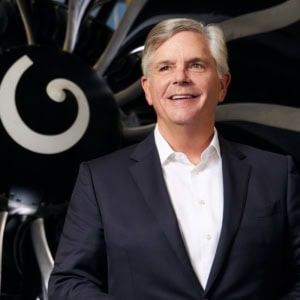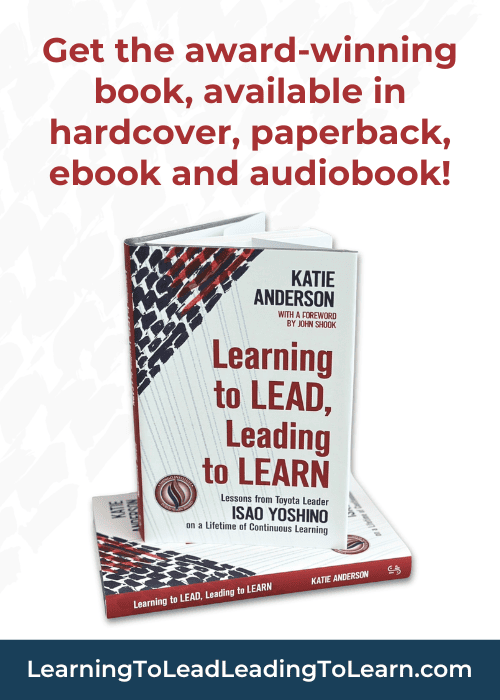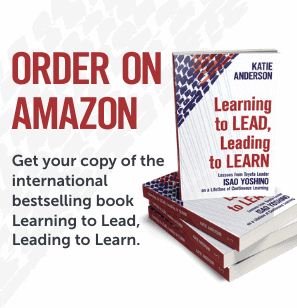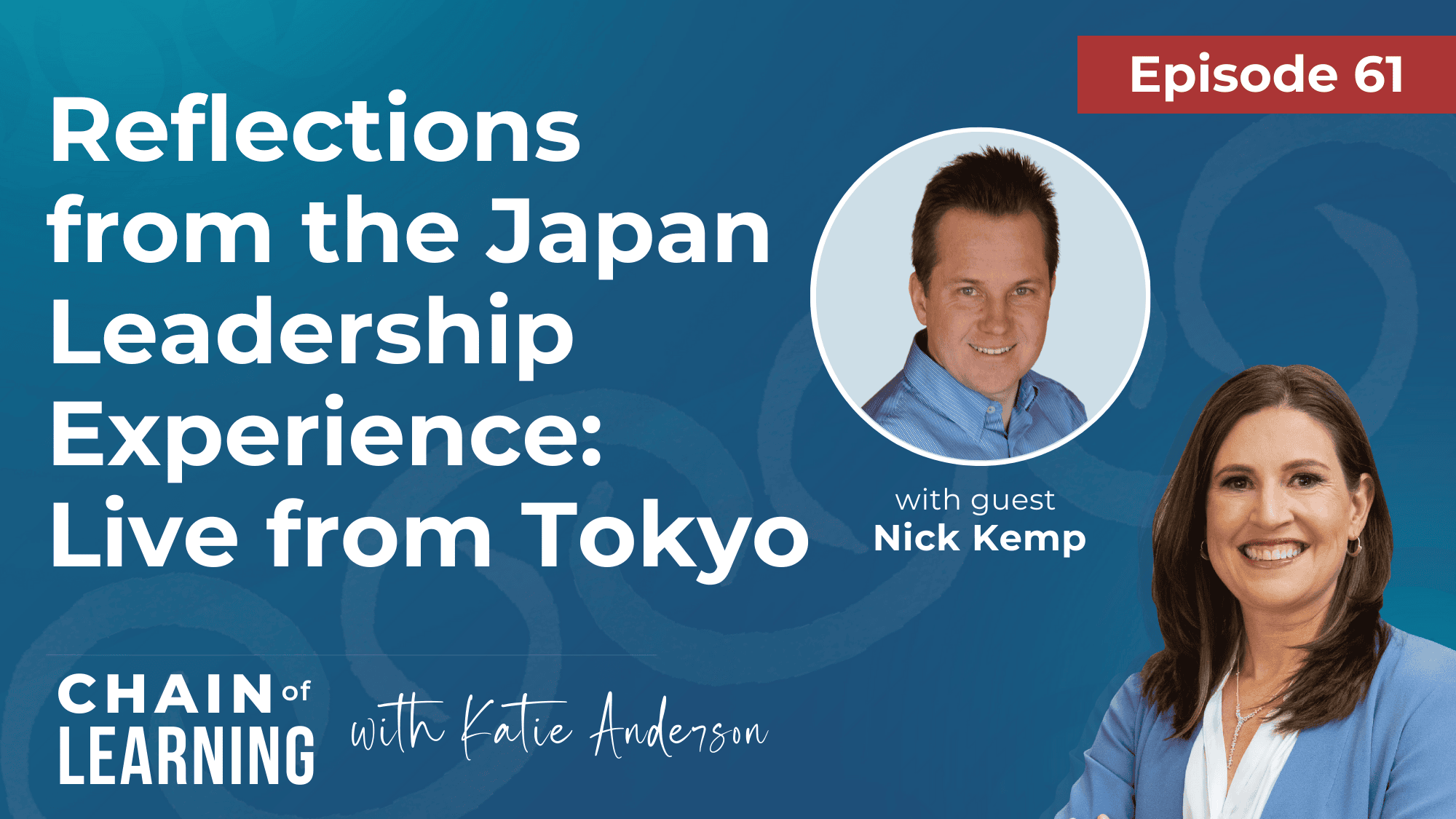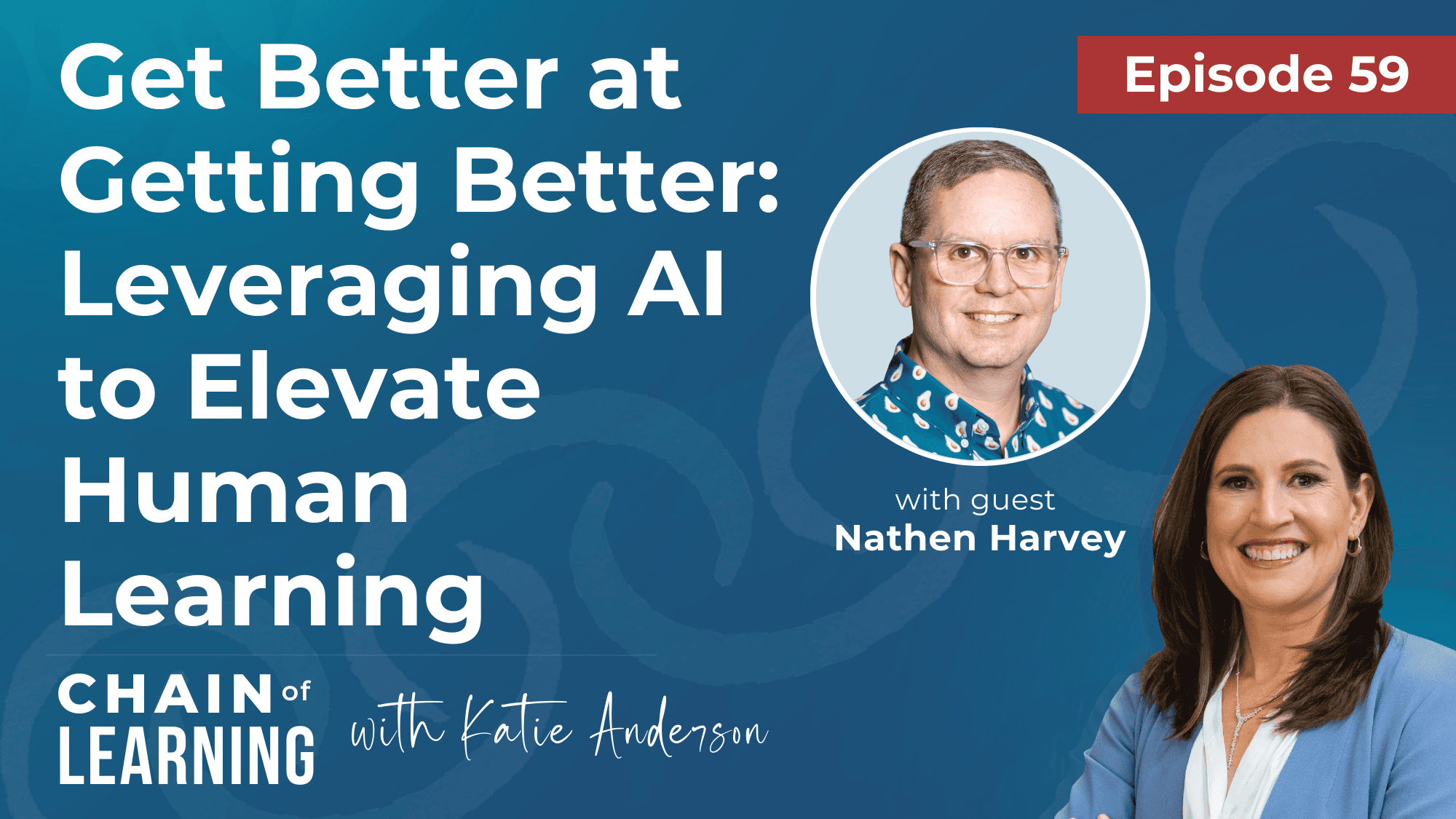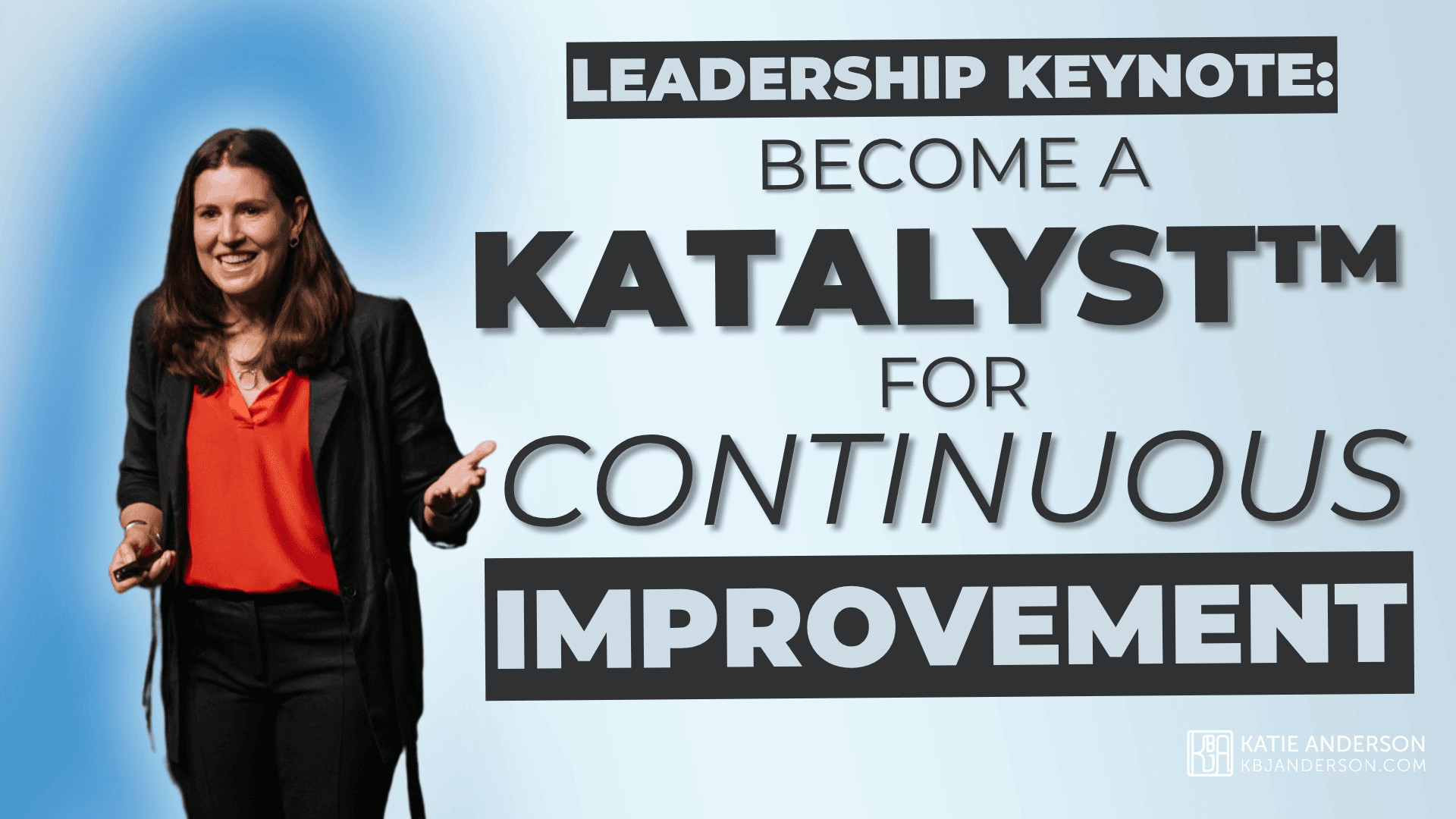Leading Lean at GE Aerospace: A Fireside Chat with CEO Larry Culp
What does it really take to become lean—not just do lean?
This is the secret to transformational lean leadership that Larry Culp, CEO of GE and GE Aerospace shared with me on stage three years ago.
In this special bonus episode, I want to share his insights and wisdom about leadership and lean culture with you.
This episode marks two milestones in my own Chain of Learning® journey:
️The two-year anniversary of the launch of this podcast!
The three-year anniversary of my interview with Larry Culp.
These two moments are deeply connected and they tell a powerful story about learning, leadership, and continuous improvement in action.
To celebrate these events, I’m bringing you back to my “fireside chat” with Larry Culp—recorded live on stage at the AME Conference in Dallas in 2022.
It’s a rare, candid look at how one of today’s most respected executives leads with a lean mindset to practice intentional leadership, humility, and continuous learning to reshape culture, improve decision-making, and lead sustainable organizational transformation at scale,
You’ll also hear how this conversation became a defining moment for me—ultimately inspiring the launch of the Chain of Learning® podcast—and why its lessons on lean leadership are just as relevant today.
In this episode, you’ll learn:
✅ Why even senior leaders and CEOs need a coach or teacher—and how having a trusted mentor helps accelerate learning and growth
✅ The importance of shifting from answers to questions—and why Breaking the Telling Habit® matters
✅ Why embracing mistakes and “bad news” builds psychological safety, and a stronger foundation for continuous improvement
✅ The power of going to see—going to gemba (the place work happens)—and how its essential for lean transformation
✅ How embracing the awkwardness of learning—going slow to go fast—helps leaders model humility and build trust through transparency
Listen Now to Chain of Learning!
Tune in to hear Larry Culp’s insights and wisdom about leadership, lean culture, and GE’s lean journey.
Watch the Episode
Watch the full conversation between me and Larry Culp on YouTube.

About Larry Culp
Larry Culp became CEO of GE Aerospace in July 2022 and became Chairman in April 2024, following its launch as an independent public company. He previously was the CEO of Danaher, which has been a great lean leadership and business success story.
Larry is focused on creating a lean culture of continuous improvement, strategy alignment, and people-development as the leadership culture at GE.
It was an incredible honor to not only hear Larry Culp when he spoke at the AME 2022 annual conference in Dallas, but to have the opportunity to interview him on stage in a “fireside chat” about his leadership approach, his top recommended leadership books, and why he is so passionate about lean and the Toyota Way concepts.
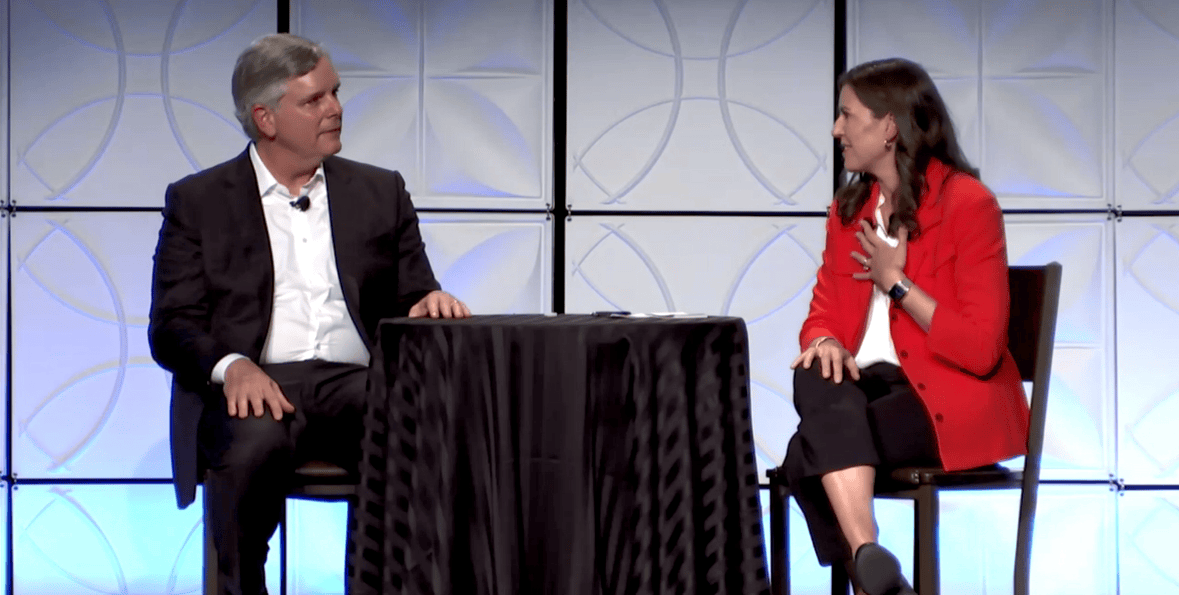
Learning to Lead, Leading to Learn to Practice Lean and Be a Better Leader
I was thrilled to discover that Larry Culp had not only read my book Learning to Lead, Leading to Learn but also highly recommended it to employees at GE.
Below is his endorsement of my book as well as a clip from his keynote about why he recommends it as a must-read book for lean leaders.
“As GE continues its lean journey, I was thrilled to come across Katie Anderson’s book—Learning to Lead, Leading to Learn—and recommended it to all our employees. Isao Yoshino’s personal journey is inspiring and clearly demonstrates how lean is about fundamental process improvement, with an eye toward better results. If you are looking for an approachable way to learn lean, I highly recommend Katie’s book.” –Larry Culp, Chairman and CEO, GE and CEO, GE Aerospace

I am grateful to Larry Culp for embracing the messages of Learning to Lead, Leading to Learn and inspiring so many leaders and senior executives to embrace lean leadership as the way to achieve important business results.
GE’s Lean Mindset Event
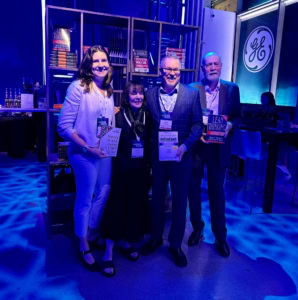
Less than a year after this fireside chat with Larry Culp, I was invited to GE’s Lean Mindset event as an influencer in the lean and continuous improvement world.
While I was there, I was able to interview speakers like Carol Dweck and sign copies of my book for hundreds of leaders.
That experience became the catalyst for this very podcast.
If you haven’t already — tune into Episode 6: Inside the Lean Mindset to hear leadership insights from the following world class leaders:
✅ Eric Klein – Culinary Vice President and Partner at Wolfgang Puck Catering, who also led the production of the breakfast and lunch service using continuous improvement lean practices
✅ Dr. Lisa Yerian – Chief Improvement Officer at The Cleveland Clinic, who was also one of the mainstage speakers
✅ Betsy Bingham – Vice President of Lean Operations at GE Aerospace
✅ Phil Wickler – Chief Transformation Officer for GE Aerospace
✅ Pat Byrne – Senior Vice President for Operational Transformation at GE
Reflect and Take Action
What powerful and humble reflections from a CEO who is truly walking the walk, sharing not just his successes, but also the learning and unlearning it’s taken to become a more effective leader.
As Larry said, he’s not leading with lean for the sake of lean. It’s because he sees it as the way to achieve real business outcomes.
Creating sustainability at times of uncertainty, building capacity for growth and empowering teams to solve meaningful problems for their customers.
That’s the real heart of lean leadership, using learning as a lever for results that matter.
As you reflect on this conversation, I invite you to consider what is one habit or mindset that you might need to unlearn to lead more effectively?
And how can you model curiosity, humility in learning, even when the path forward feels uncertain?
Important Links:
- Check out my website for resources and ways to work with me
- Connect with Larry Culp
- Follow me on LinkedIn
- Read the recommended book that inspired Larry to share with the GE organization
- Episode 46 | Lead Change at Scale: Inside GE Aerospace’s Lean Cultural Transformation with Phil Wickler
- Episode 6 | Inside the Lean Mindset: Behind-the-Scenes Leadership Insights
- Episode 3 | A Growth Mindset is the Foundation of a Continuous Improvement Culture with Carol Dweck
- Episode 2 | Leading with the Heart to Create a Culture of Continuous Learning with Jamie Parker
Listen and Subscribe Now to Chain of Learning
Listen now on your favorite podcast players such as Apple Podcasts, Spotify, and Audible. You can also listen to the audio of this episode on YouTube.
Timestamps:
02:51 – Larry Culp’s view on lean as a lever to embrace cultural disruption at GE
04:14 – The importance of having a coach and a teacher to help guide you as a senior leader
05:34 - Larry’s shifts in his leadership approach as he was learning how to lead
07:47 – How to really listen and hear what others meant to say
07:28 – How to become a better listener and ask better questions
08:20 – The difference of implementing lean versus becoming lean
10:12 – What lean means to you as a leader
12:25 – The importance of doing the work even though you have a coach
13:49 – How to build failure and mistakes into your leadership practice and culture
15:06 – Fostering an environment where sharing mistakes and challenges are acceptable
17:55 – Larry’s key takeaway from Katie’s Shingo award winning book, “Learning to Lead, Leading to Learn”
21:16 – What to assess when going to Gemba
24:13 – What Larry has learned from his sensei and going to Japan that has helped him be a more impactful leader
28:11 – How hoshin kanri is connected to your approach leadership approach
29:24 – The impact of cross-functional collaboration
31:22 – Managing awkwardness as a leader while learning new leadership skills
32:49 – Making the shift in being okay with not having all the answers
34:56 – Future improvements of GE
36:33 – The purpose of daruma dolls in setting intentional goals
37:46 – The real heart of lean leadership in using learning as a lever for results that matter
Full Episode Transcript
Larry: [00:00:00] These lean principles, these tools would be to be widely adopted, but most importantly, you need a leadership condre that not doesn’t simply mouth the words or hire consultants. But they can really walk the talk.
Katie: Welcome the Chain of Learning with the links of Leadership and Learning Unite. I’m your host and fellow learning enthusiast, Katie Anderson.
This week marks two special milestones, the three year anniversary of my fireside chat with GE Aerospace, CEO Larry Culp, and the two year anniversary of this podcast itself. These two moments are connected and they’re part of my own chain of learning, and that’s why I’m excited to share this conversation with you as a special bonus episode.
If you’d like to watch the video conversation with me and Larry Culp, you’ll find the link in the show notes or on my YouTube channel. A little backstory. In the summer of 2022, Larry brought my book “Learning to Lead, Leading to Learn” with him on vacation, and he came back inspired and recommended it to the entire [00:01:00] GE organization in a company-wide email.
A few months later, I found myself on stage with him at the AME Conference in Dallas, facilitating a conversation about leadership, learning and lean. Less than a year after that, I was invited to GEs Lean Mindset event as an influencer in the lean and continuous improvement world, interviewing speakers like Carol Dweck and signing books for hundreds of leaders.
That experience became the catalyst for this very podcast. So to celebrate these milestones, I’m bringing you that original conversation, a fireside chat with Larry Culp that explores what it really means to become lean. Not just do lean. There are so many rich insights from Larry in this episode, including the importance of shifting from answers to questions and why breaking the telling habit matters.
Why embracing mistakes and bad news builds trust in learning the power of going to see, going to gemba, the place the work happens, having a coach and going slow to go fast. And what Larry has [00:02:00] unlearned about leadership along the way. It’s a rare and candid look at how one of today’s top executives practice humility, reflection, and continuous improvement.
Now let’s tune in to my previously live onstage conversation with Larry Culp on what it means to lead with Lead. Larry, I’ve been looking forward to this chat and we’ve been gathering questions from the audience too. Well, I thought maybe we’d start off, um, well, first let me introduce myself. You heard that I’m the author of “Learning to Lead, Leading to Learn,” which we’ll talk about in a moment.
I also have my own consulting practice and play a role here at AME. I’m the director of the San Francisco Bay Area Consortia, and I’ve, it’s been a great conference and I’m thrilled to dive into leadership to lean with Larry. Uh, the topic of the conference is embracing disruption, and I’m curious to know how you see lean as a lever to embrace cultural disruption at GE.
Larry: Well, I’m not sure fitty anyone [00:03:00] ever necessarily embraces disruption, right? Change is not something everyone relishes, but I think what we’ve been able to do with Lee and GE with an eye toward cultural evolution, cultural disruption, has actually changed the way we work. It’s one of the things I really appreciated from an academic perspective when I was between full-time jobs and I was teaching lot people talk about culture, but how do you actually change culture?
You gotta change the way you work. And that’s why these events early on with the senior leadership team were so instructive because I could have gone on and on and on about the sort of culture that I envisioned for our company, but would kind of hear us song got that very first bat. And asked all the operators to come to the front of the auditorium at our Greenville, South Carolina plant and gave them, asked all of us to give them a round of applause.
It spoke volumes as to how we were gonna work, and that, I think is [00:04:00] really, Howard tried to drive the cultural change working differently, not just talking about it. Yeah.
Katie: You’ve mentioned Kasan, uh, and I know he’s been a strong coach and sensei for you. Uh, can you talk to about importance of having a coach and a teacher to help guide you as a senior leader?
Larry: Well, I, I think Katie, certainly as a CEO, and this is my second time in the role, really have to be careful about what comes to you and how it comes to you. A news does not typically travel fast. People can be overly deferential. However hard you try. Having a coach can be an incredibly effective conduit and mirror, especially for CDOs because you, you need people who will tell you what you’ve screwed up.
Got hear. Usan doesn’t through an interpreter, but I think I now understand certain concepts in Japanese that don’t [00:05:00] require interpretation and to see him disappointed. And the pace of change at GE from time to time, we will, we will share it is in. So those are the sorts of things I think regardless of whether you’re a CEO or in a, in a different role, getting those outside perspectives are, are just again, in value.
Katie: Few things I wanna dive in here first, uh, lemme go back to the concept of bad news. But first I wanna talk about, you know, as you’ve gone on this lean leadership transformation of your own self, what are some of the things that you really had to shift in your own leadership approach as you were practicing and learning how to really lead in this way?
Larry: Well, I would say that you don’t go to the Hartford Business School, uh, to learn how to ask questions. You, you, you’re asking a lot of questions and you get it all. A certain instinct toward, uh, answering up, [00:06:00] right. I think many of us know, probably all of us do that. The, one of the true principles of, of, of lead and something that has been part of the cultural evolution at GE is the leader as question, as opposed to answer.
Right? And, and framing that debate. Uh, one of the things that I had a chance to do when I was teaching. It is really understand the power of, of, of a good question. Of a timely question. So those are the the sorts of things that come to my mind when you ask about that.
Katie: Yeah. I talked about we all have to figure out how to break the telling habit to become more effective, and we are not even aware of how much we’re telling when we think that that’s maybe what we need to do as a leader or as a coach to tell people what to do.
But how do you, how do I foster that a a and.
Larry: How
Katie: do you learn to listen?
Larry: We’re all busy, right? Uh, [00:07:00] bow Hill is wonderful technology that has some of us working remotely. How do you really listen? How do you hear what people have said? How do you hear what they meant to say? How do you hear what they didn’t say?
Right? That, I think that takes a lot of practice. So it’s not just the art question, I think it’s the, the active listening, which is so us an imperative for leaders today.
Katie: What’s helped you become a better listener as well as a better question asker?
Larry: I would say simply practice with respect to, to questions and feedback.
I had a chance to run a p and l in Danaher very early in my career. Uh, was one of the great gifts. Professionally, when you have that role for the first time, it’s not as if you’re looking for a lot of help, right. And that’s where getting that opportunity in a lead environment, having a number of good senses, uh, in my ear all the time really [00:08:00] helped me understand what I wasn’t listening, uh, or when I was perhaps hearing things, but, but missing some of the other, uh, cues that are part of communication, but practice, Jason practice
Katie: and feedback how zoo someone hold, hold up that mirror to you.
I agree. Yeah. It’s so invaluable. Um, I’ve heard you talk about the difference of implementing Lean versus really becoming lean. I’d like to hear more about that difference for you.
Larry: Sure, sure. There were a lot of companies when I was at Danaher who would say we want to do that too. And we’ve seen a number of fill in the blank business systems.
I’m sure there are a number of outstanding, uh. Implementations, but I think we were well aware that that was really code for, we’d like to have the Danaher multiple, but do we [00:09:00] really have to put the work in? Right. And, and it was never about hiring your consultant with all due respect to our friends at, at Shin It, it was really never simply about doing a number of of events.
One of the things that drives me crazy today, Larry, we’ve done 17 events this year. That’s great. Any with impact fiercely, right? But I think over time what we understood was all of that’s important. If you’re really going to Ron the business in this way, these lean principles, these tools need to be widely adopted.
But most importantly. You need a leadership cadre that not, doesn’t simply mouth the words or hire consults, but that can really walk the talk. And I think that was one of the great advantages of what we’ve been able to do, uh, what they still do at Danaher, what, what I was a part of for, for 25 years. We had a senior team that was really [00:10:00] bought into it.
We grew up with it. We really knew no other way to manage. And that I think allowed us to perpetuate. A, uh, a lean enterprise over a long period of time.
Katie: What would you say to other senior executives who aren’t sure if they really, like, they hear about lean, they want the outcomes, they want it now, they want it fast.
Yeah. But still on the fence about what that means for themselves as leaders. What, what are your words of advice to them?
Larry: The ones at GE today or elsewhere? Lb,
Katie: any, both. Yeah. You can tell that you can set some direction at ge. You can’t.
Larry: Well, I, I think that the message I have given and will continue to convey to the, to the GE team, and I think it’s applicable everywhere.
You’ve gotta go slow to go fast. I’m sure there are different views in the room. If, if your idea of a kaizen is an afternoon or a couple of days, I think it’s a shortcut. Yeah. I don’t, I don’t think you have [00:11:00] endured the pain of Tuesday afternoon or Wednesday morning. Right when you have no idea how you’re gonna get to Friday.
Yeah. There’s a long day, a long night ahead of you. That I think is the, the, the sort of experience which really crystallizes these, uh, the, the, these sorts of instincts and these sorts of skills. Uh, I’m just used to a, a, a big believer in leaders needing to understand that not that leaders can then go off and spend 20 weeks a year.
Running events, but having a good eye for a good event critical, having a, a support system to drive that effort. But then back to your, your question about questions and answers, right? How, how do you evolve your, your own approach? And it’s something I’ve seen with the GE tape because the GE tape very much if they drew up with an eye toward answers coming from leadership, not necessarily [00:12:00] questions.
But get an incredibly capable team that is making that at the individual level, really making that, that transition. I couldn’t be more proud, but you, you have to, you have to invest the time. You need some feedback loops. You need a coach. Uh, but have faith, because I think there’s so many examples to suggest is it’s within the realm of the possible,
Katie: but I hear you say it’s, they have to take it on themselves.
It’s not something, it can be delegated. It also involves your. Yourself as well in that role?
Larry: Sure. Because how many of us have been a part of the Flavor of the day program somewhere? Right? Where the CEO’s got a great idea, maybe they’ve gone to an a ME event. Uh, they, they have religion that day, but then something else comes up.
But they hired the consultant, had a couple event, you, you know, what, what I call that fake leap. Uh, what. It. And unfortunately we probably have, have all seen examples of [00:13:00] it. I’m fearful, I may see an example tomorrow. Uh, but you gotta call ’em out, right? You’ve gotta have an eye for it. You’ve gotta have the, the fortitude to call it out.
Not in a what the heck are you doing, sort of way. But how about maybe a different approach? How about be actually play? Who keeps here and be serious about it? And over time, I think people wanna win. I think if you give people an opportunity to see. The, these approaches, these principles, these, these tools are, are really impactful.
You get most folks there. Not everybody,
Katie: but
Larry: most
Katie: enough, multi culture. I wanna go back to this concept of that then having a culture where it’s okay to have failures, to have mistakes, and to learn from them. How do you, how important do you think it is to build that into your leadership, practice and culture?
Larry: Well, I’ve, I’ve seen a [00:14:00] number of examples, uh, over my career where bad news is not travel fast and it can be fatal. I, I remember we were, I think I can tell this story, I getting into trouble. Uh, we, we were visiting a company, it was back in my old life, a company we were looking to acquire. And it was a company that had encountered some issues, believe it there, kept the innocent.
I remember vividly somebody saying, during the course of due diligence, we no longer talk about bad news. It has been deemed bad for morale. At that very moment, I said to myself, we should buy this company. Great bones, obviously up on the rocks. But if that’s been the mindset. This company can be turned around, right?
’cause we’ll let the bad news in. We’ll deal with that reality. We’ll work those problems and [00:15:00] over time people will see what has been historically so strong about this business and continues to this day.
Katie: So how did you start fostering that environment that made it okay to share maybe the imperfections or the challenges, the mistakes?
Larry: Katie, I, I think it, it, it’s largely about. How you deal with bad news. I, I, I, I could encourage all of you to come to me if we were working together. I want to hear the bad news. I want to hear it fast. Probably not gonna happen, right? But a week or two will pass. Somebody will have some issue, and that will be the moment of truth, right?
You shoot the messenger or do you listen even if you are unhappy. Yeah. And do you then go into problem solving though, right, both to contain and to deal with root cause? That’s not, and that’s a lot easier said [00:16:00] than done. But I had a wonderful opportunity early in my time at ge, uh, where I think there was a perception the messengers were, were, did not shot, dealt with otherwise.
Where I could, I could, I, I had a sense that there was bad news brewing. I could see somebody almost trend like. And we had a great conversation. He had the confidence, the fortitude, the trust to bring it forward. We had a really good discussion about it, painful for all of us. We ultimately, I think, dealt with the issue, but it was the beginning, Russ, at least for, for the broader team of sea.
I can walk that talk. I can handle bad news. I would not shoot messengers now. I don’t think we’ve completely turned that at ge. I’m not sure we ever necessarily a achieved perfection in that regard at Danaher, but [00:17:00] any of us, again, it is not a CEO thing. Any of us have the opportunity to create that environment where people wanna bring forward an issue and, and know they’re gonna get help.
They will be, uh, they will be chastised. Because if you don’t do that,
Katie: no.
Larry: These things submarine on, you know, the next thing you know, um, something really bad’s gonna happen.
Katie: It’s the foundation and the critical factor that makes all the learning possible. Uh, and it’s actually, I want to transition to what you’ve learned from my book.
This is the, the foundation of, of Mr. Yoshino’s experiences at Toyota. The way they made so successful is their willingness to embrace mistakes of failure earning. And I think that that’s often. Something so missed in an organization, like, and I was so honored to hear that you read my book and loved it, and I’d love to hear more of like, what was the key takeaway for you from this?
Larry: Y’all probably think we, we’ve set you up and you’re on this and I, I obvious this is [00:18:00] not the case. We, we do a quarterly session right after earnings, we’ll do this next Wednesday where we basically do a GE wide broadcast, uh, we call it leadership exchange, goes for about three hours. Uh, I host it. Bring in outsiders.
We highlight some of our better performance. Good conversation. We’re at a break and I’m walking off the stage at break the go to our podcast. This group will get the, uh, double entendre here if it’s called. End on that note.
Katie: Got it. It’s, I think, the best podcast title in the Lean World actor. Sorry, mark.
Larry: So I, I, I’m, I’m walking off stage. They turn it up. And I hear two sentences on Hoshin Kanri, the subject, dear and dear to my choir. And I wheel around and I said, who’s that? Because it might have been the most coherent, uh, two sentences on Hoshin I’ve ever heard, and I’ve tried to be coherent on the topic.
It [00:19:00] failed for 20 years. Anyway, long story short, Katie Anderson wrote this book, so it goes into the beach bag. So I’d bought your book. Thinking I was going to learn more about how to communicate more clearly as to what Hoen is and how to use it. You don’t have a lot of pages on Hoshin anymore? No, but what I was so thrilled about, really two things.
One, you she son’s personal journey and for folks, particularly for folks at GE, to see that transformation. I, it, it’s just, it’s, it’s a personal journey. Well, well told in a way that I thought was accessible, but, but the other thing that was key for me and I, and the reason I recommended it to the GE crowd is we’re still, I think getting more people to understand it’s not just about manufacturer.
Yes. That’s where it starts. Yes. That’s the best play. Just to learn. ’cause you can touch it, you can feel it, you can hear it, you can smell it, [00:20:00] but it is applicable everywhere. Right. And I thought your book really talked about being not through that manufacturing lenss, but again, more, more broadly. So it was really for those two reasons, complete surprises that had me.
Okay. Suggesting your book and not knowing, I promise, not knowing we’d be together here. Day of me,
Katie: it all, it all came together and that was my great honor and privilege to get to know. Isao Yoshino was a 40 year Toyota leader who was part of. Helping take Toyota from a more manufacturing process side, the Toyota production system, to really creating what we now know as the Toyota Way, which is the Toyota management system.
And so that journey. As well. So thank you. And I, I appreciate that. Thank you. Uh, one of the foundations of Lean that we all know is the concept of go to gemba, go to the place the work happens, and I’ve heard you talk about the importance of going to see for you personally. Mm-hmm. And, uh, up twofold for you.
What’s your, when you go [00:21:00] out to any of your, you know, front line, uh, areas, what’s your intention as a leader? And then second fold. How do you use that information to help you be more, make better decisions as a leader?
Larry: When I go to gemba, what I really am trying to do is assess probably two things fundamentally.
One state of the lean transformation of that, that area. Something that I’m sure many, many of us do, and I’m sure many could do it better than I, than I do. But also I’m trying to assess how strong the leadership is with respect to those core principles. And there are all sorts of cues, right, that help me understand just how well understood and [00:22:00] how deeply embedded the principles are as opposed to.
Asthmatic, fake lean efforts, uh, and you don’t really have to ask consumer. Many great questions. Couple of good ones. Uh, having met at a lot of places over, over time to, uh, to get there is, is CEO of a portfolio in the way that I was at Danaher and, and running GE today. A company much, much bigger than than Danaher.
Those trips to gemba aren’t necessarily all of the pieces to the puzzle that I need to solve for. Uh, it’s, it’s in many respects, an unrepresentative data set, but it’s all I got, right? So I try to do that in a factory, in a lab, at a customer site, so that I’m collecting as many of those [00:23:00] puzzle pieces as I can connecting them.
As best I can, knowing that it’s an incomplete picture, but it beats the heck out of somebody setting me a PowerPoint deck, right? It beats the heck out of consultant, uh, walking me through a presentation, gimme their version. I’m sure people manage that way. Oh, sure. Many quite successfully. I have no idea.
I have no ability to do that, and frankly, no, no interest because being a gemba is not only instructive. In those, in those ways. It’s fun. I, I, I had a three hour flight two weeks ago from the west coast into Cincinnati to, to be with the team. I’m on Fuse a few hours later after that breakout or that report out, I was on fire and I was on fire because I’m feeding off their energy, their, their momento.
Uh, and that’s just, I, I think the way, the way you want it to work.
Katie: Yeah. And. Nothing lights [00:24:00] me up more too than seeing people being able to tackle and solve meaningful problems and to be part of that as well. Um, you know, if, if we take a, a look too at, you know, some of the other key things that you have learned from your sensei or, and going to Japan.
What are some of those other practices that you, besides asking questions and listening, which I believe is the foundation that you’ve really taken forward to be more impactful as a leader, even growing to where you are now?
Larry: Well, there’s a, there’s a lot that comes to mind. Kay. What we asked that I, I, I would just go back to maybe the, in the Greenville, uh, vignette.
A moment. For a moment. Kind of hear us on. Consistently the beginning of a Kaizen Week, at the end of a Kaizen week, and all throughout focuses on the operator, [00:25:00] and it really comes down to the ex, you know, his, his appreciation for the expertise, the people closest to the work and his respect for the people, uh, doing crook.
I get easy things to say, but at every turn I just, whenever I’m with him, appreciate how, how far I need to go still in, in, in both of those areas. It’s also something that I, I hope other GE leaders see because he, uh, he needs it. Wow. It is just that is, that is the, the intensity around respect for people that he breaks.
The, the other is just, and frankly, his attention in detail, uh, his sense of urgency. He [00:26:00] just has such outsized expectations for what we can get done in a week that he’s constantly, uh, and Kyle Harris’s now in his seventies, pushing us, moving us. He’s hard to keep up with. But at the same time, I, I remember we were, uh, we were at Whales.
We had some of the pictures from Body Whale, I think it was Wales. We were on our way to dinner. I went into the men room. He’s bent over picking up a, uh, a, a used paper towel. I don’t think that was his, he said a client’s men’s room on the way to dinner. He’s taking the time to clean the floor. You see that it just, uh, it, it, it puts everything in perspective is what that sort of leadership model represents.
Katie: Absolutely. I lived in Japan for two years, and one of the things I was really struck by was people’s respect for each other, the respect for the environment and the community, regardless of what our al [00:27:00] status was working together.
Larry: And that’s, you, we go back to some of the, the, the books I, I remember as a, as a very young man.
One of the things that, uh, Carolina would do, you can’t do it so much anymore given how quick, how fast basketball is. But if you watch the old tapes of Carolina with somebody, typically an All American would score. They point in the day. You point to have, or well, you yourself, back in the day, Michael Jordan said, Sam worthy, let’s guy appointed the Larry who passed him to the ball.
Right. That’s the person who really should get the credit. The crowd’s going crazy. They’re, they’re pointing to the passer, not themselves who scored. That’s a sort of selflessness, I think that links a lot of these ideas and, and enterprises over time.
Katie: Absolutely. And then the, the core sort of trifold purpose of a leader that I talk about meco is you set the direction.
Where do we need to go with [00:28:00] those seemingly impossible goals that, uh, your sensei set. But then providing the support and the connections for people to deserve and improve yourself. Exactly. Uh, so going to that setting direction, and let’s go back to the topic of hoshin kanri and, and the most important things for senior leaders to be doing is studying the direction, providing those connections.
Uh, what was it that really struck about what I said about hoshin and how is that, uh, connect the sort of your approach,
Larry: Katie? I think it was the, the emphasis on cross-functional collaboration. I, I’m sure all of you are hoshin experts, but let’s all remember that first time we saw an ex matri, right. It probably were temporarily ed.
It, it’s not necessarily intuitive. Give it a a little bit of time. It, it, it sued us. I, I believe that, that that ocean concrete is the most important tool in the toolkit that any, uh, general manager could have. [00:29:00] Just, I believe that’s strongly. I think what you do a very nice job of, and what you did on the, the podcast is, is underscore that that really only works in that cross-functional collaboration, that it can and should be a Katalyst for working that way.
And that’s been one of the biggest points of emphasis for us at GE Aerospace, tremendous capability. But over time what we’ve developed are very strong functions. Nothing wrong with that, but you don’t win function by function, by function, you win, right? On an enterprise level, no customers ever come to us because of this function or that function.
They come to us because of all the functions. How do we really make them come together? And Hoshin has been a strong Katalyst for that. Lemme tell you, when that team is sitting around the table, really in a deep potion mode, the fur flies. It’s match. Because we’re really doing better [00:30:00] work than we would do in our functional, uh, silos.
It takes a while for that to really, uh, move in deeply. But given what I’ve seen, I throw that out a couple of years. Again, I don’t want to get into the stock price, but I just feel really good about what that team or our team has kicked off.
Katie: That’s great. And how do you start making those connections? And if you just have it as a tool.
It’s all not gonna go so far. It’s got the conversations that
Larry: right
Katie: happen across it,
Larry: month in, month out, month in, month out. And, and I tried to share with the GE team that this may be awkward and it has been awkward for, for some of our misses. Again, it’s go slow up, go fast. I promise you, by the end of the year when we have several reps behind us, we’ll look back, we’ll see how silly we were.
To sign up for some things, how badly if you understated what was possible in other [00:31:00] areas, we’ll reset it. It will rinse and repeat, and you do that over time. The, uh, the power of compounding really takes a effect.
Katie: E eun, we feeling awkward and I think that that’s one of the things I ob observed with all the leaders I work with in my own experience too, that learning something new is awkward.
There’s struggle in it, and how do you help? Manage your own sense of awkwardness as a leader who’s supposed to, you know, be leading this team, but still knowing that you’re doing things differently and have opportunity to learn?
Larry: Well, Katie, I’ve never felt awkward.
Katie: No.
Larry: Um, let, let’s just that, um, I, I think that, I don’t know if it’s being in the role a second time.
I don’t know if it’s being an outsider. I don’t know if it’s having acquired a certain age.
Katie: Uh.
Larry: People know what you’re good at. People know what you’re Amy so good at. Uh, when you try to fool [00:32:00] them, you’re probably only fooling yourself really, right? And I, I just think that, uh, it, it’s so much more powerful if you can find it in yourself, uh, to know what you don’t know something, and, and, and reach out for help to acknowledge, uh.
Uh, mistakes, own mistakes, uh, and move forward. I think, I think people respect that. I think a lot of people, uh, engender followership that way. Uh, there’s really no way to get better.
Katie: You have to go through that struggle. You know, you talk about as nerdy how ask questions, and I think many people believe that when you get to a leadership role, that you’re supposed to be the one with all the answers.
And so to then start shifting to asking more questions does feel awkward and uncomfortable. How, how did you start making that shift for yourself or being okay with not the, the one with all the answers? Well,
Larry: I, I think one of the things that I was [00:33:00] fortunate to do early in my, uh, my career is, is get the opportunity to, to run Vita Root.
Uh, I knew that, uh, I didn’t have all the answers. Right. So in, in, in a, in a way, he was a humility, uh, board of a sense of survival. And the good news was we had an outstanding team, uh, Dick Lucas, our engineering leader, phenomenal, uh, just leaning on so many of those people, I think made me better, uh, is, is the leader, but also engendered a level of collaboration at teamwork.
It really allowed us to just go on a, on a phenomenal runaway. We compounded at 70% organically in that business over a decade, and that wasn’t me. I probably got more credit for that than I, than I ever deserved, but it was just a heck of a team [00:34:00] fortunate. I didn’t go in there thinking, okay, I’m a hot shot, Harvard NBA, let me go dole out instructions.
It was really a discovery journey for all of us and ultimately. We perform really well, but we also created a culture, I think, very representative of some of these principles that we’ve talked about.
Katie: Well, we don’t think lean just for the sake of doing it. We want you to achieve, you know, important business outcomes for your customers, and you have some big audacious goals out there.
How do you see the next four years with using in. Management need leadership to be the way to manage through other things of uncertainty. The, you know, we have so many issues. We have the pandemic, we have supply chain issues. How, how is this gonna help you achieve what you need to do for your business and your shareholders?
Larry: Well, let, let’s, um, go back quickly to the idea of the foundation daily management and, uh, poche. [00:35:00] We will see what the economy breaks next year. Uh, clearly storm clouds are gathering. I think that’s, uh, been well documented. We have tremendous path log at our aerospace business. We are ramping like crazy and we will ramp for the foresee of future.
So a lot of what we’ve talked about clearly is an enabler with respect to shorter cycle times, more capacity, and in turn a, uh, a ramp rate. Commensurate with the backlog that we enjoy in that, in that business. Healthcare, similarly, different commodities, very different products, but healthcare really the world over post pandemic, both the public and private providers is a, uh, a business that has, I think, a very strong future ahead of it.
We, our, our past due backlog is, is not something we’re very proud of. Again, laying in a stronger foundation will help us with that and. [00:36:00] Our, our renova business isn’t in that position today, but the inflation reduction act, we see 10 years of sustained demand in, in our wind business in particular that we’re gonna need to keep pace with.
But what all three businesses are independent, ocean Congress become even more important, right? Keeping the senior team focus, making sure we’re declaring our ambition in ways that we can implement. And I think as you look at each of the three companies, I hope that’s what. All of all of you see from GE over time.
Katie: I don’t know if you’ve been encountered these dolls from Japan. They’re called daruma dolls. I am obsessed with them, and when you have a goal, you fill in the dolls left eye, and they represent the Japanese proverb. Fall down seven times, get up eight. And I know you have some big goals to achieve, so I wanted to give you a daruma to help.
Stay the course and when you can eventually achieve your goal, you will fill it into, they’re weighted at the bottom. Oh, this is, they should invite themselves back up, but they’re [00:37:00] weight at the bottom. So Larry, she made us Toma serve you well as you achieve some big audacious goals for GE and keep leading to learn and, and leading the way.
And thank you so much for everything you had to share with us here today. And then I do wanna give you a signed top view. Ah, okay. I know you already have one. Thank you one too. So face every.
What powerful and humble reflections from A CEO who is truly walking the walk, sharing not just his successes, but also the learning and unlearning it’s taken to become a more effective leader. As Larry said, he’s not leading with lean for the sake of lean. It’s because he sees it as the way to achieve real business outcomes.
Creating sustainability at times of uncertainty, building capacity for growth and empowering teams to solve meaningful problems for their customers. That’s the real heart of lean leadership, using learning as a lever [00:38:00] for results that matter. As you reflect on this conversation, I invite you to consider what is one habit or mindset that you might need to unlearn to lead more effectively?
And how can you model curiosity, humility in learning, even when the path forward feels uncertain. If this conversation has sparked something for you, I encourage you to explore a few related episodes, including episode 46 with Phil Wickler, GE Aerospace’s, chief Transformation Officer on how he, Larry and the entire team at GE Aerospace are creating and sustaining a people first lean transformation.
Episode three with Carol Dweck, where we talked about the connection of a growth mindset and a lean mindset, and reflected on her experience on attending GEs Lean Mindset event, and some of my direct reflections from the Lean Mindset event, including episode two with Jamie Parker, where we talk about attending the event in episode six, which are behind the scenes [00:39:00] interviews that I did at the Lean Mindset event to see.
Perspectives on what it takes to build and sustain a learning culture at scale. Thank you for tuning into this bonus episode of Chain of Learning and for being part of two years of Chain of Learning together. If you enjoy this show, take a moment to subscribe on Apple, Spotify, YouTube, or wherever you listen, so you never miss an episode.
And please leave a quick rating or review to share your top takeaways on this episode or others. Because it really helps others find and join our chain of learning too. Thanks for being a link in my chain of learning today. I’ll see you next time. Have a great day.
Subscribe to Chain of Learning
Be sure to subscribe or follow Chain of Learning on your favorite podcast player so you don’t miss an episode. And share this podcast with your friends and colleagues so we can all strengthen our Chain of Learning® – together.

